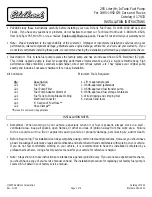
Pro
te
c
t
ed
b
y
co
p
y
rig
h
t.
C
o
p
y
in
g
fo
r
pr
iv
a
t
e
o
r
c
o
m
m
e
r
c
ia
l
p
u
rp
o
s
e
s
,
i
n
p
a
rt
o
r i
n
w
h
o
le
,
is
n
o
t
p
e
r
m
it
t
e
d
u
n
l
e
s
s
a
ut
ho
r
i
s
ed
b
y
V
olk
sw
a
ge
n AG
.
V
olk
s
w
a
g
en
AG do
es
n
ot g
uar
ante
e
or a
c
c
ep
t
a
ny
li
a
b
i
li
t
y
w
ith
r
e
s
p
e
c
t
t
o
th
e
c
o
rr
e
c
t
n
e
s
s
o
f
in
fo
r
m
a
tio
n
in
th
is
d
o
c
um
en
t.
C
o
py
rig
ht b
y
V
olk
sw
a
ge
n
A
G.
– Select “Diesel OBD” -arrow-.
Specified data input for EET:
There are different ways to enter the specified data:
♦ 1) Manual input
♦ 2) Bar code input of EET data sheet
♦ 3) ELSA web service
Note
♦
To use the ELSA web service, the vehicle diagnostic tester ,
which is used for the exhaust emissions test, must be integra‐
ted in the workshop network.
♦
For the ELSA web service the vehicle specified data are au‐
tomatically transmitted via the network to the respective mask.
Manual specified data input for EET:
Note
All test conditions and data required for exhaust emissions test,
see ⇒ Data sheets for exhaust emissions test for respective en‐
gine.
– Perform manual data input according to instructions on dis‐
play.
– Enter displayed values on EET data sheet in column “Test
values for exhaust emissions test” on display as follows:
1 - Speed for conditioning
2 - Number of throttle bursts for conditioning
3 - Engine oil temperature (min. value)
4 - Select engine oil temperature measurement procedure
5 - Idling speed
6 - Rev limit
7 - Rev limit measuring period (1 second)
8 - Opacity figure (average)
9 - Select probe type (No. of probe)
10 - Select measuring mode
11 - Measured period portion
– When all data have been entered properly, press
→
button
-arrow-.
Specified data input for EET as bar code:
– If specified data for EET are available as bar code, read bar
code of EET data sheet with bar code reader.
Golf 2013 ➤
Maintenance - Edition 10.2012
5. Exhaust emissions test
113










































